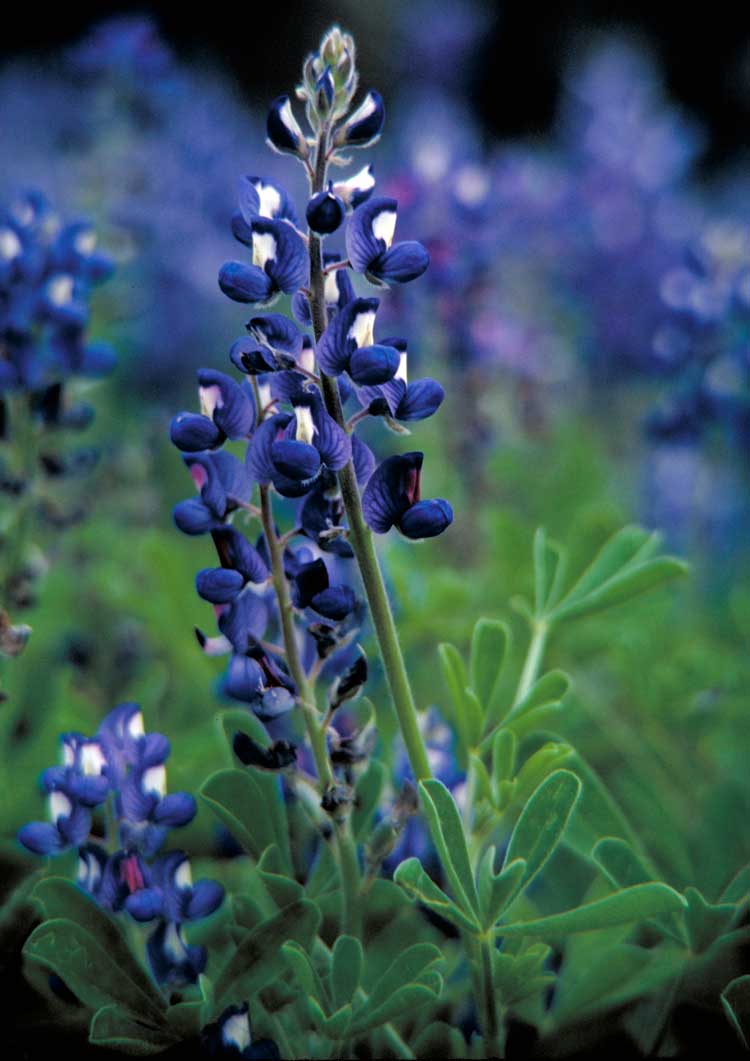
Lupinus texensis , Photo: U.S. Fish and Wildlife Service
Classification System: APG IV
Superregnum: Eukaryota
Regnum: Plantae
Cladus: Angiosperms
Cladus: Eudicots
Cladus: Core eudicots
Cladus: Rosids
Cladus: Eurosids I
Ordo: Fabales
Familia: Fabaceae
Subfamilia: Faboideae
Tribus: Genisteae
Genus: Lupinus
Species: Lupinus texensis
Name
Lupinus texensis Hook., 1836
Synonyms
Lupinus leonensis S.Watson
Lupinus texensis f. albus Standl.
Distribution
Native distribution areas:
Continental: Northern America
Regional: Mexico
Mexico Northeast
Regional: Southern Central USA
Texas
Introduced into:
Louisiana
References: Brummitt, R.K. 2001. TDWG – World Geographical Scheme for Recording Plant Distributions, 2nd Edition
References
Primary references
Hooker, W.J. 1836. Curtis’s botanical magazine, comprising the plants of the Royal Gardens of Kew, and of other botanical establishments in Great Britain; with suitable descriptions. Vol. LXIII [= Vol. X of the second series.] pp. 3458–3541. Lovell Reeve, London. BHL Reference page. : 62 3492
Links
Govaerts, R. et al. 2021. Lupinus texensis in Kew Science Plants of the World online. The Board of Trustees of the Royal Botanic Gardens, Kew. Published online. Accessed: 2021 Jan 28. Reference page.
International Plant Names Index. 2021. Lupinus texensis. Published online. Accessed: Jan 28 2021.
Tropicos.org 2021. Lupinus texensis. Missouri Botanical Garden. Published online. Accessed: 28 Jan 2021.
Hassler, M. 2021. Lupinus texensis. World Plants: Synonymic Checklists of the Vascular Plants of the World In: Roskovh, Y., Abucay, L., Orrell, T., Nicolson, D., Bailly, N., Kirk, P., Bourgoin, T., DeWalt, R.E., Decock, W., De Wever, A., Nieukerken, E. van, Zarucchi, J. & Penev, L., eds. 2021. Species 2000 & ITIS Catalogue of Life. Published online. Accessed: 2021 Jan 28. Reference page.
USDA, ARS, Germplasm Resources Information Network. Lupinus texensis in the Germplasm Resources Information Network (GRIN), U.S. Department of Agriculture Agricultural Research Service. Accessed: 07-Oct-06.
Vernacular names
العربية: ترمس تكساسي
English: Texas Bluebonnet
español: Altramuz de Texas
suomi: Teksasinlupiini
Lupinus texensis, the Texas bluebonnet or Texas lupine[1] is a species of lupine found in Texas, and the Mexican states of Coahuila, Nuevo León, and Tamaulipas. With other related species of lupines also called bluebonnets, it is the state flower of Texas.[2]
It is an annual which begins its life as a small, gravel-like seed. The seed has a hard seed coat that must be penetrated by wind, rain, and weather over the course of a few months (but sometimes several years). In the fall, the bluebonnets emerge as small seedlings with two cotyledons, and later a rosette of leaves that are palmately compound, with five to seven leaflets 3–10 cm long, green with a faint white edge and hair. Growth continues over the mild winter, and then in the spring takes off, rapidly grow larger, before sending up a 20– to 50-cm-tall plume of blue flowers (with bits of white and occasionally a tinge of pinkish-red). The scent of these blossoms has been diversely described; many people say they give off no scent at all, while a few have described the scent as 'sickly sweet'.
Bluebonnet seeds have a hard outer shell to protect from dry conditions as the plant grows better in moist years. Seeds may be scarified - a process to weaken the seed casing to encourage germination - before being stored. If scarified and stored at twenty-two degrees Celsius, the seeds face no reduction in germinability one year after being harvested and treated.[3]
It has been found in the wild with isolated mutations in other colors, most notably all-white flowers, pink, and the maroon 'Alamo Fire' variation. These mutations have since been selectively bred to produce different color strains that are available commercially.
Texas recognizes all native lupine species occurring in the state as the official state flower. That fact leads to other species such as L. subcarnosus and L. havardii also being referred to as bluebonnets, but distinctions are seen among the species that differentiate them from L. texensis.
References
USDA, NRCS (n.d.). "Lupinus texensis". The PLANTS Database (plants.usda.gov). Greensboro, North Carolina: National Plant Data Team. Retrieved 24 June 2015.
How did bluebonnets become state flower?
Effect of Scarification, Seed Storage Temperature, and Relative Humidity on Lupinus havardii Wats. and Lupinus texensis Hook. Seed Germination
Retrieved from "http://en.wikipedia.org/"
All text is available under the terms of the GNU Free Documentation License

